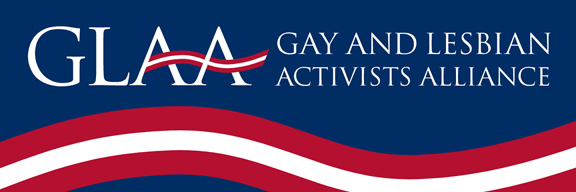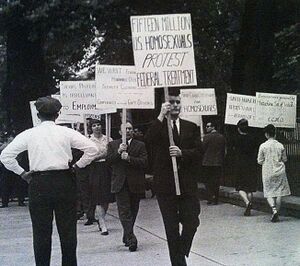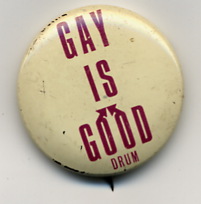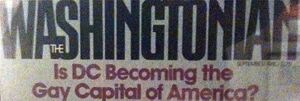Gay and Lesbian Activists Alliance of Washington, D.C. 1971-2010
Peaceful participation in the political process.
The Gay and Lesbian Activists Alliance of Washington, DC is the oldest continuously active gay rights organization in the United States. Founded on April 20, 1971, as the Gay Activists Alliance, the group dedicated itself to securing the "full rights and privileges" of citizenship for the gay community through "peaceful participation in the political process." Formed in response to the first popular election in modern times in the District of Columbia, GLAA has been a powerful, nonpartisan advocate within the District's political community from its inception. In late 1970, four years before it granted the District of Columbia Home Rule, Congress permitted the District to elect a nonvoting
delegate to the House of Representatives. Unimpressed by the announced candidates' attention to gay issues, a small group of Washington gay activists decided in early 1971 to offer their own candidate. With help from the Gay Activists Alliance of New York (GAA/NY), volunteers blanketed the city, acquiring over 7,000 signatures and securing a place for Frank Kameny on the March ballot.
"Kameny for Congress" was the first campaign by an openly gay person for a national office. The founder of the gay liberation movement in Washington, Frank Kameny worked as an astronomer with the federal government before he was fired in 1957 because of his sexual orientation. When he filed as an independent candidate with the DC Board of Elections, Kameny declared, "This campaign represents the first organized effort by the homosexual community to enter the political arena firsthand, in our own behalf," and promised that it would be "a formidable group to be reckoned with." Please read more about this campaign, and the early years of the District's gay-rights movement here.
In March 1971 Kameny came in fourth in the six-way race, garnering nearly 1,900 votes. Buoyed by the amount of publicity generated, Kameny's campaign workers decided to form a permanent organization patterned after GAA/NY, which had assisted in the signature drive. Named GAA/DC, the group differentiated itself from counter cultural groups such as the Gay Liberation Front formed after the Stonewall Riots in 1969. GAA/DC established a traditional structure with officers and committees, restricted its focus to issues germane to gays and lesbians, and disavowed the use of violence.
Though its aim was liberation, its strategy was to act within the existing order. GAA was incorporated in the District of Columbia in 1974 and later granted tax-exempt status by the IRS. Seeking to represent the interests of a diverse community, GLAA has remained independent and nonpartisan. During its first year GLAA held a forum for candidates in the fall election for DC School Board and rated individual candidates on their support of gay rights. This interaction with the candidates and subsequent lobbying resulted in the School Board's enactment of a resolution prohibiting discrimination within the school system based on sexual orientation, the first such resolution by a school board in the United States. With the advent of Home Rule in 1974, GLAA expanded its candidate forums and ratings process to include mayoral and council races. By this time it had already been successful at persuading the appointed city council to pass a human rights law, making DC the first major city in the country to outlaw discrimination based on sexual orientation.
In addition to rating candidates for office and lobbying elected officials, GLAA has, since its inception, worked on a variety of projects, including police relations, media relations, education, and health issues. The following chronology is offered to highlight significant projects and accomplishments of the Gay and Lesbian Activists Alliance. An historical sketch of the city's oldest gay organization, it chronicles much of the history of the Washington gay community.
Since 1990, GLAA has celebrated its anniversary with the annual Distinguished Service Awards. GLAA presents the DSA to local individuals and organizations that have served the gay, lesbian, bisexual, and transgender community in the national capital area. In 2010, the awards will be presented at GLAA’s 39th Anniversary Reception on Tuesday, April 20.
— Originally prepared by David K. Johnson
GLAA TIMELINE 1971-2010
GLAA's DISTINGUISHED SERVICE AWARDS
TIMELINE: MARRIAGE EQUALITY IN WASHINGTON, DC
GLAA PRESIDENTS
James McClard 1971
Joel Martin 1971-1972
Bob Johnson * 1972
Bill Bricker * 1972
Patricia Radomski 1972-1973
Bob Carpenter * 1973-1974
Cade Ware * 1974-1975
Craig Howell 1975-1976
Jim Zais * 1976-1977
Mayo Lee * 1977-1978
Bob Davis 1978-1979
Mel Boozer * 1979-1981 (2 terms)
Andy Hirsch 1981
Jeff Levi 1982-1983
Steve Smith * 1983-1984
Rich Llewellyn 1984-1986 (2 terms)
Lorri L. Jean 1986-1988 (2 terms)
Roger Doughty 1988-1990 (2 terms)
Mindy Daniels 1990-1992 (2 terms)
Jeff Coudriet 1992-1995 (3 terms)
Rick Rosendall 1996-1999 (3 terms)
Craig Howell 1999-2000 (1 term)
Bob Summersgill 2000-2003 (3 terms)
Kevin Davis 2003-2005 (3 terms)
Christopher L. Neff 2006
Barrett Brick 2006-2009 (3 terms)
Mitch Wood 2009-present
* - deceased
PERSONAL HISTORIES
In this section of our exhibit, we have created pages for GLAA members who had their own stories to tell:
REFERENCES
- Clendinen, Dudley and Adam Nagourney (1999). Out For Good: The Struggle to Build a Gay Rights Movement in America. New York, Simon & Schuster. ISBN 0684810913.
- Kaiser, Charles (1997). The Gay Metropolis: 1940-1996. New York, Houghton Mifflin Company. ISBN 0395657814.
- http://rainbowhistory.org
- http://dcwatch.com
- http://www.wusa9.com/news/columnist/blogs/2009/01/dispatch-records-for-dc-fire-that-left.html
- http://www.metroweekly.com/feature/?ak=1550 <comments />



